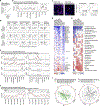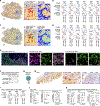CXCL9:SPP1 macrophage polarity identifies a network of cellular programs that control human cancers
- PMID: 37535729
- PMCID: PMC10755760
- DOI: 10.1126/science.ade2292
CXCL9:SPP1 macrophage polarity identifies a network of cellular programs that control human cancers
Abstract
Tumor microenvironments (TMEs) influence cancer progression but are complex and often differ between patients. Considering that microenvironment variations may reveal rules governing intratumoral cellular programs and disease outcome, we focused on tumor-to-tumor variation to examine 52 head and neck squamous cell carcinomas. We found that macrophage polarity-defined by CXCL9 and SPP1 (CS) expression but not by conventional M1 and M2 markers-had a noticeably strong prognostic association. CS macrophage polarity also identified a highly coordinated network of either pro- or antitumor variables, which involved each tumor-associated cell type and was spatially organized. We extended these findings to other cancer indications. Overall, these results suggest that, despite their complexity, TMEs coordinate coherent responses that control human cancers and for which CS macrophage polarity is a relevant yet simple variable.
Conflict of interest statement
M.J.P. has served as consultant for AstraZeneca, Elstar Therapeutics, ImmuneOncia, KSQ Therapeutics, Merck, Siamab Therapeutics, Third Rock Ventures., Tidal. A.M.K. is a founder and shareholder in 1CellBio, Inc. R.W. is cofounder of T2 Biosystems, Lumicell, Aikili, Accure Health, and advises Moderna, Alivio Therapeutics and Tarveda Therapeutics; he reports personal fees from ModeRNA, Tarveda Pharmaceuticals, Lumicell, Alivio Therapeutics, and Accure Health. R.W. is an adviser to ModeRNA, Lumicell and Accure Health. S.I.P. has served as consultant for Abbvie, Astrazeneca/MedImmune, Cue Biopharma, Fusion Pharmaceuticals, MSD/Merck, Newlink Genetics, Oncolys Biopharma, Replimmune, Scopus Biopharma, Sensei Bio, and Umoja Biopharma. She has received grants/ research support from Abbvie, Astrazeneca/MedImmune, Cue Biopharma, Merck, Sensei, and Tesaro. The wife of R.B. is an employee and shareholder of CSL Behring and R.B. received speakers fee from Janssen and is a mentee of the ENDEAVOUR-Breast program of Daiichi Sankyo. P.W. has served as consultant for Merck-Serono, Novartis, Sanofi, Bayer and Genentech. W.R. is currently a Senior Computational Biologist at Pfizer Inc. N.H. advises and holds equity in Related Sciences/Danger Bio, advises Repertoire Immune Medicines, holds equity in BioNTech and receives funding from Bristol Myers Squibb. G.G. receives research funds from IBM, Pharmacyclics, Ultima Genomics and is an inventor on patent applications related to MSMuTect, MSMutSig, MSIDetect, POLYSOLVER, SignatureAnalyzer-GPU and MinimuMM-seq. G.G. is a founder, consultant and holds privately held equity in Scorpion Therapeutics. G.G. received travel support from Caris Life Sciences. R.B., P.W., R.W., S.I.P and M.J.P. are listed as authors on a patent (provisional application number 63/503,528) submitted by Massachusetts General Hospital that covers a predictive signature of tumor prognosis and treatment efficacy.
Figures




References
MeSH terms
Substances
Grants and funding
LinkOut - more resources
Full Text Sources
Other Literature Sources
Medical
Molecular Biology Databases
Research Materials
Miscellaneous

